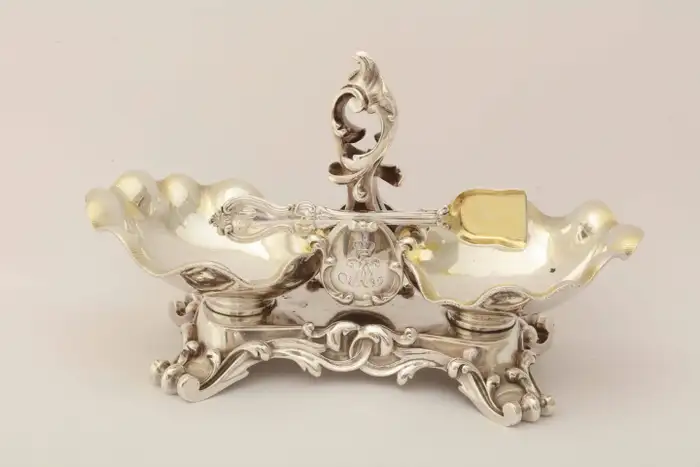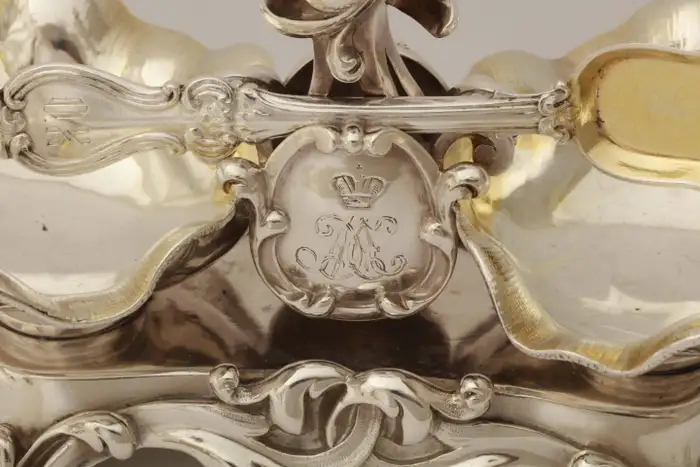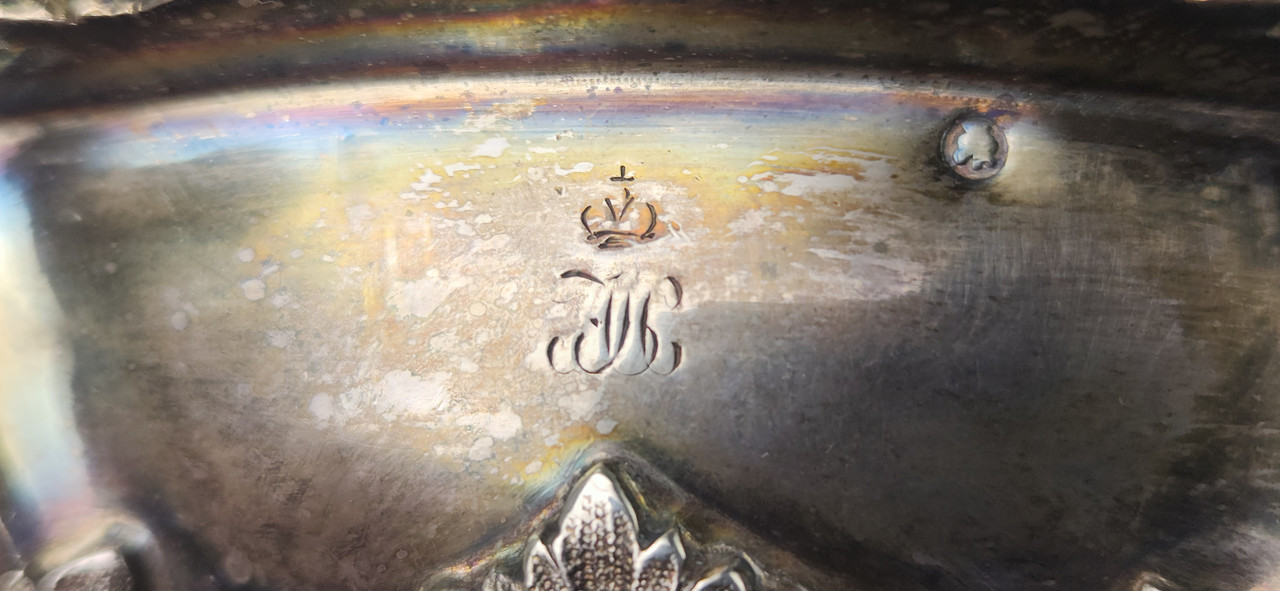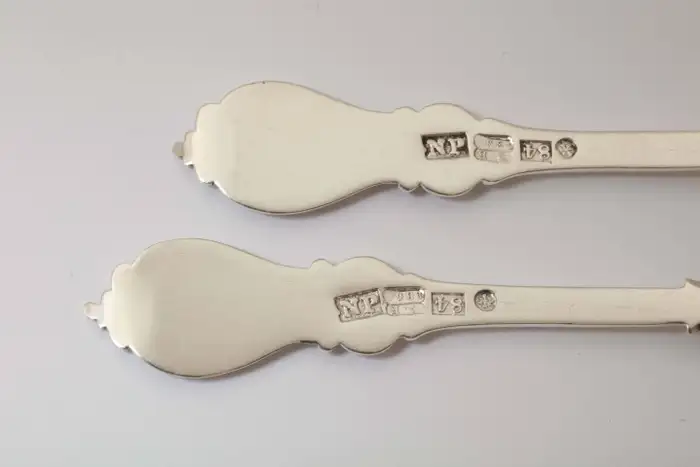Important Russian Silver? Grand Duke Crown & Imperial Eagle
Re: Important Russian Silver? Grand Duke Crown & Imperial Eagle
Thanks for the info!
I am not saying that such documents do not exist. I said that I didn’t see them either. However, it is strange that the age of the deceased person is not written in the documents.
I have nothing more to say than I did in my first post. I wasn’t looking for information about who the silversmith is, but in the PL book there is such information...
I am not saying that such documents do not exist. I said that I didn’t see them either. However, it is strange that the age of the deceased person is not written in the documents.
I have nothing more to say than I did in my first post. I wasn’t looking for information about who the silversmith is, but in the PL book there is such information...
Re: Important Russian Silver? Grand Duke Crown & Imperial Eagle
You are welcome. Well, Postnikova is not complete far from it. This is not a simple case. There are too many variables and that makes is a bit complicated. Nice discussion anyway.
Re: Important Russian Silver? Grand Duke Crown & Imperial Eagle
I want to thank you all very much for all the help you have given! I'm truly impressed. The maker seems to be quite the predicament! Has anyone ever seen a case where a mark was used after the maker's death? I'm not sure if we will ever know the true answer, but it has been incredibly interesting you hear all of your thoughts.
Juke, I'm glad to know it is a salt and pepper holder now, as I wasn't sure, and the picture of the different lettering styles was incredibly helpful, I never would have figured out the "AN" monogram myself, and I'm ecstatic that it very likely may be from Alexander Nikolaevich's service.
Also, if any of you have any knowledge of old German/Euro silver, can you give your thoughts on my second post about the pieces that I acquired with this Russian salt cellar? I believe they were part of William 1st service set from 1806. The thread link is: https://www.925-1000.com/forum/viewtopic.php?t=63259
If anyone knows of any other Alexander Nikolaevich service pieces in museums or that came up for sale be sure to let me know!
Eric
Juke, I'm glad to know it is a salt and pepper holder now, as I wasn't sure, and the picture of the different lettering styles was incredibly helpful, I never would have figured out the "AN" monogram myself, and I'm ecstatic that it very likely may be from Alexander Nikolaevich's service.
Also, if any of you have any knowledge of old German/Euro silver, can you give your thoughts on my second post about the pieces that I acquired with this Russian salt cellar? I believe they were part of William 1st service set from 1806. The thread link is: https://www.925-1000.com/forum/viewtopic.php?t=63259
If anyone knows of any other Alexander Nikolaevich service pieces in museums or that came up for sale be sure to let me know!
Eric
Re: Important Russian Silver? Grand Duke Crown & Imperial Eagle
"..., I'm glad to know it is a salt and pepper holder now..."
I am not an expert in this matter, but I would like to see confirmation of this idea.
I am not an expert in this matter, but I would like to see confirmation of this idea.
Re: Important Russian Silver? Grand Duke Crown & Imperial Eagle
That is the common and typical way at least with spice sets in Europe starting from the 19th century. For sure the salt is the most common one and in addition I can not think of any other spice with it than pepper.
Also the compartments clearly and visibly shows that the salt cellar has been more deteriorated on one of the compartments where the salt was. Thereby would also prove there was some other spice in the other compartment. I don't see a reason to have two different compartments for just salt so pepper is the only other option. This is just my opinion.
The object is rare as it includes two compartments which also shows it is from a high end silver service for a wealthy person. Almost all of salt cellars have just one compartment. Salt was the most common spice and pepper as a more expensive spice only affordable by the rich.
Re: Important Russian Silver? Grand Duke Crown & Imperial Eagle
Thank you! I have never seen peppers stored open. It may lose its properties and fly apart when air moves. But I do not insist on my point of view.
Here are typical pepper containers of those times.


Here are typical pepper containers of those times.


Re: Important Russian Silver? Grand Duke Crown & Imperial Eagle
Just a short point out,
The fact that you might find a punch with a deceased master has been told here in the past and has an explanation. When a married master passed away his wife retain the right to run the workshop and use her late husbands punch until her own death. The widow could also apply to the guild to use/have her own punch. This was not uncommon in former Russia. Irrespective of the punch of her own, the widow was not a graduated master appointed by the guild. She only run the workshop but this "master punch" with her initials has led to the incorrect "illusion" that there were female masters/goldsmiths appointed by the guild in former Russia. Not a single one has been demonstrably identified/found. The workshop was not the place for women. It was a rather "dirty" place and a harsh language was used. In those days women/wives were supposed to stay home take care of her husband and raise children but not "working".
Regarding the salt cellar. I share Juke's opinion, it is a most likely a salt cellar! Moreover, use Internet's search function with "Russian salt cellar" and see it for yourself. There are many pictures to been seen. Actually on the dinner table there could be personal salt cellars or a common one. How the dinner table was set and with what in those days is another long and interesting story. But there is a point in Mart's claim. Having pepper and salt in the same container was not so common.
The fact that you might find a punch with a deceased master has been told here in the past and has an explanation. When a married master passed away his wife retain the right to run the workshop and use her late husbands punch until her own death. The widow could also apply to the guild to use/have her own punch. This was not uncommon in former Russia. Irrespective of the punch of her own, the widow was not a graduated master appointed by the guild. She only run the workshop but this "master punch" with her initials has led to the incorrect "illusion" that there were female masters/goldsmiths appointed by the guild in former Russia. Not a single one has been demonstrably identified/found. The workshop was not the place for women. It was a rather "dirty" place and a harsh language was used. In those days women/wives were supposed to stay home take care of her husband and raise children but not "working".
Regarding the salt cellar. I share Juke's opinion, it is a most likely a salt cellar! Moreover, use Internet's search function with "Russian salt cellar" and see it for yourself. There are many pictures to been seen. Actually on the dinner table there could be personal salt cellars or a common one. How the dinner table was set and with what in those days is another long and interesting story. But there is a point in Mart's claim. Having pepper and salt in the same container was not so common.
Re: Important Russian Silver? Grand Duke Crown & Imperial Eagle
There were two types of spice sets, either open ones or closed ones as shakers. They were used both for salt and pepper.
Here is a types of open ones. The two on the left are salt cellars and the one in the right is for salt, pepper and mustard.

I agree it is a possibility that the one we have been discussing about could have been used double sided for salt. My thought comes from the fact that this is a high end silver set which also included a pepper side.
Here is a types of open ones. The two on the left are salt cellars and the one in the right is for salt, pepper and mustard.

I agree it is a possibility that the one we have been discussing about could have been used double sided for salt. My thought comes from the fact that this is a high end silver set which also included a pepper side.
Re: Important Russian Silver? Grand Duke Crown & Imperial Eagle
Maybe, but I'd take a closer look at these places. This looks like a support for the elegant lids. A handle in the middle would perhaps be a nice addition. Perhaps any table spices can be placed here.


Re: Important Russian Silver? Grand Duke Crown & Imperial Eagle
Of course the owner of the silver set would have had the opportunity to use it either way.
However these bowl type of salt cellers didn't have lids. I guess in mid 19th century they where not so keen on hygien at the table. Either they took the spice with a small spoon or just with fingers.
However these bowl type of salt cellers didn't have lids. I guess in mid 19th century they where not so keen on hygien at the table. Either they took the spice with a small spoon or just with fingers.
Re: Important Russian Silver? Grand Duke Crown & Imperial Eagle
A salt cellar is a very common object as a part of a dinner set. The over hundred bowl types Russian silver salt cellars I have seen on auctions from mid 19th century didn't have a lid. You can easily search these on the auction sites.
Yes you could claim they have lost their lid but I don't think it would be the case. And yes you can always find a couple exceptions with a lid.
I think anyway we can agree on most part of the case.
Thanks for Tipton444 for showing the object. Rarely seen any royal authentic objects on this site!
Yes you could claim they have lost their lid but I don't think it would be the case. And yes you can always find a couple exceptions with a lid.
I think anyway we can agree on most part of the case.
Thanks for Tipton444 for showing the object. Rarely seen any royal authentic objects on this site!
Re: Important Russian Silver? Grand Duke Crown & Imperial Eagle
https://www.925-1000.com/forum/viewtopic.php?t=63259
Of the William 1st service set from 1806 I can say the larger one is a sugar-caster spoon with which sift sugar on the food so bigger sugar parts were left in the bowl.
My best guess why the spoons are marked by different silver smiths is that spoons were ordered in many cases from subcontractors for a bigger case and in your case there just happend to be spoons from different subcontractor makers.
Of the William 1st service set from 1806 I can say the larger one is a sugar-caster spoon with which sift sugar on the food so bigger sugar parts were left in the bowl.
My best guess why the spoons are marked by different silver smiths is that spoons were ordered in many cases from subcontractors for a bigger case and in your case there just happend to be spoons from different subcontractor makers.
Last edited by oel on Tue Feb 20, 2024 6:38 am, edited 1 time in total.
Reason: Added link to topic in question
Reason: Added link to topic in question
Re: Important Russian Silver? Grand Duke Crown & Imperial Eagle
"...The over hundred bowl types Russian silver salt cellars I have seen on auctions from mid 19th century didn't have a lid. ..."
I don't think there is a salt shaker in this thread.
I don't think there is a salt shaker in this thread.
Re: Important Russian Silver? Grand Duke Crown & Imperial Eagle
I think there was a misunderstanding, with bowl types Russian silver salt cellars I referred to the one we have been discussing about, not a salt shaker. A type of salt cellar with a lid came in use more in the beginning of 20th century.
It is interesting that in the 19th century a Russian salt throne had a lid, however this was due to the fact that it presented a chair.
It is interesting that in the 19th century a Russian salt throne had a lid, however this was due to the fact that it presented a chair.
Re: Important Russian Silver? Grand Duke Crown & Imperial Eagle
Thank you guys very much, this is really great information. Very interesting that a wife was able to retain the rights to the master's punch!
I just found a pair of salt cellars from the wedding service of Grand Duke Michael Nikolaevich (1832-1909), which have a nice resting spot for a salt cellar spoon, and no lids. Now I'm trying to figure out if my salt cellar was made for the Grand Duke Michael Nikolaevich as well, as opposed to Alexander Nikolaevich (1818-1881), because the "MN" monogram might be more of a match than the "AN" monogram.... It's a bit hard to tell as some parts of it have worn off, but what do you guys think?
Thank you Juke for your input on the William I silver thread!



I just found a pair of salt cellars from the wedding service of Grand Duke Michael Nikolaevich (1832-1909), which have a nice resting spot for a salt cellar spoon, and no lids. Now I'm trying to figure out if my salt cellar was made for the Grand Duke Michael Nikolaevich as well, as opposed to Alexander Nikolaevich (1818-1881), because the "MN" monogram might be more of a match than the "AN" monogram.... It's a bit hard to tell as some parts of it have worn off, but what do you guys think?
Thank you Juke for your input on the William I silver thread!



Re: Important Russian Silver? Grand Duke Crown & Imperial Eagle
And this one, from Grand Duke Mikhail Pavlovich service (1798-1849). Pretty incredible!


Re: Important Russian Silver? Grand Duke Crown & Imperial Eagle
Interesting Tipton 444, Would you mind shoving the marks/punches too. They are also of interest. Revert to this later when I have seen the punches.
Re: Important Russian Silver? Grand Duke Crown & Imperial Eagle
The first salt cellar with the spoons had two pictures of the punch, but the second set of salt cellars was from Christies and only had that one picture.





